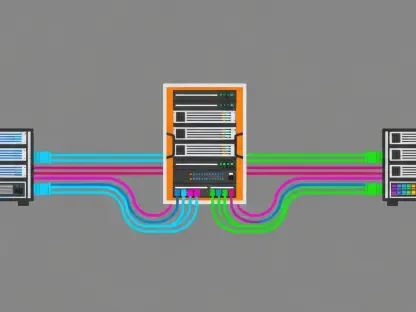Quantum computing signifies a revolutionary shift in computing technology. Unlike classical computing, which uses bits that exist in one of two states (0 or 1), quantum computing utilizes qubits—units that can exist in multiple states simultaneously due to the principle of superposition. This property allows quantum computers to process multiple calculations simultaneously, offering exponentially greater processing power for specific tasks compared to classical computers. The capabilities of quantum computing are exemplified by the problem of factoring large numbers. Classical computers find this task computationally intensive and time-consuming as the numbers grow larger. Conversely, quantum algorithms, such as Shor’s algorithm, can factorize large numbers exponentially faster, which may have profound implications for the future of cryptography and cybersecurity. Beyond cryptography, quantum computing’s potential extends to drug discovery, materials science, financial modeling, and artificial intelligence. For example, quantum simulations can model molecular interactions at unprecedented speeds, which can significantly accelerate the identification and development of new compounds and therapies in drug discovery.
The Role of Open Source in Quantum Computing Development
Fostering Collaboration
Open source initiatives are significantly propelling the quantum computing field forward. The open source philosophy encourages collaboration, transparency, and community-driven innovation—a stark contrast to the traditionally closed environment of proprietary software development. Open source frameworks for quantum computing, such as IBM’s Qiskit and Google’s Cirq, exemplify how collaboration can accelerate innovation. These frameworks have attracted contributions from global communities of researchers and developers who have collectively tested, refined, and developed new tools to enhance these frameworks. By pooling their resources and expertise, these communities are accelerating the pace of innovation. This collaborative model allows for a more iterative and dynamic development process where ideas and solutions can be shared rapidly and widely, leading to more robust and versatile quantum computing tools. Moreover, the inclusive nature of open source projects means that a diverse range of perspectives contributes to the development process, ensuring that the tools and frameworks developed are not only cutting-edge but also versatile and adaptable to a wide array of applications.
Enhancing Accessibility
Projects like Cirq lower the barriers to entry for those interested in quantum computing. By providing accessible frameworks for building and manipulating quantum circuits, these projects democratize access to quantum computing, inviting contributions from a growing community of practitioners and enthusiasts. The open source model is conducive to innovation as it allows researchers to experiment freely without the constraints tied to proprietary software. They can access and modify the source code of quantum computing frameworks, explore novel approaches, optimize algorithms, and develop tools tailored to specific applications. The accessibility provided by open source projects is crucial for education as well. Students and amateurs can learn and experiment with quantum computing by accessing documentation, tutorials, and community forums provided by these projects. This hands-on experience is invaluable in understanding complex quantum concepts and developing practical skills in quantum programming. As a result, the open source model is nurturing a new generation of quantum scientists, researchers, and developers who will drive the field forward.
Top Open Source Quantum Computing Frameworks and Their Use Cases
Qiskit (Developed by IBM)
Qiskit is a comprehensive open source framework for quantum computing. Researchers use Qiskit to implement and test quantum algorithms, which allows them to explore the advantages of quantum computing over classical methods. Qiskit aids in simulating quantum systems to model molecular interactions and predict properties of new compounds, benefiting chemists. Qiskit’s capabilities support the design and training of quantum machine learning models, integrating quantum computing with AI. This framework provides a robust platform for developing and testing quantum algorithms, making it a valuable tool for researchers and developers. The versatility of Qiskit is highlighted by its extensive applications in quantum chemistry. By simulating molecules and chemical reactions, Qiskit offers insights into molecular behaviors that are unattainable through classical methods. These simulations can accelerate the discovery of new materials and pharmaceuticals. Additionally, Qiskit supports the education community by offering a well-structured learning environment where beginners can code and run quantum programs while learning the theoretical foundations of quantum computing.
Cirq (Developed by Google)
Cirq allows users to construct and visualize complex quantum circuits, aiding in the understanding and analysis of quantum computations. It offers tools to optimize quantum circuits specifically for Noisy Intermediate-Scale Quantum (NISQ) devices, addressing noise and decoherence challenges. Researchers can implement hybrid algorithms combining classical and quantum computations to leverage the strengths of both. Cirq’s flexibility and powerful tools make it an essential framework for those working on quantum circuit design and optimization. Furthermore, Cirq’s emphasis on NISQ technology is vital for current quantum research focused on mitigating errors and improving the reliability of quantum computations. By providing optimization tools specifically tailored for NISQ devices, Cirq plays an integral role in making quantum technologies more practical and usable in the near term. The ability to simulate and optimize noisy environments helps in anticipating real-world challenges and developing more resilient algorithms, facilitating smoother transitions from theoretical models to practical applications.
PennyLane
PennyLane enables the design of quantum neural networks, exploring the potential of quantum computing in enhancing machine learning models. Users can implement variational algorithms for optimization tasks, addressing combinatorial problems. PennyLane provides a valuable educational tool with resources and tutorials for those interested in quantum machine learning. Its focus on integrating quantum computing with machine learning makes it a unique and powerful framework for researchers and developers. PennyLane’s approach to blending classical and quantum machine learning techniques is paving the way for new methodologies in AI research. By enabling quantum differentiation and training quantum neural networks, PennyLane opens new realms for machine learning advancements, offering possibilities that classical computers alone cannot achieve. Additionally, the framework’s educational resources bridge the gap between complex quantum theories and practical machine learning applications, fostering a deeper comprehension of how these advanced technologies interconnect.
Challenges for Open Source in Quantum Algorithms
Standardization and Interoperability
Despite the significant advances open source has made in quantum computing, it faces unique challenges. Differences in syntax and functionality across frameworks like Qiskit and Cirq make direct implementation of algorithms from one platform to another challenging. Establishing common protocols and interfaces to facilitate interoperability among quantum computing platforms is becoming increasingly important. Standardization efforts are crucial for ensuring that different frameworks can work together seamlessly. The lack of standardization can lead to fragmented efforts where innovations in one platform are not easily transferable or scalable across others. This fragmentation hinders collective progress and can slow down the overall development of quantum technologies. To overcome these challenges, industry-wide collaborations and agreements on standard protocols are necessary, facilitating a more unified approach to quantum computing development. Creating interoperable standards will streamline coding efforts and foster a more cohesive ecosystem for quantum research and applications.
Resource Allocation and Funding
Financial backing and human resources for promising open source projects are often limited, leading to stagnation or reduced community engagement. Recruiting qualified personnel with both quantum computing and open source development expertise is a considerable challenge for startups and smaller organizations. Ensuring adequate funding and resources for open source projects is essential for maintaining momentum and fostering innovation in the quantum computing field. The scarcity of resources can also affect the scalability and long-term sustainability of open source projects. Without sufficient funding, these projects may not receive the ongoing support needed for updates, maintenance, and enhancement, potentially diminishing their effectiveness and impact. Attracting investment from government bodies, corporations, and philanthropic organizations dedicated to advancing science and technology could alleviate this issue, providing the necessary support to keep open source quantum computing projects thriving and progressing.
Quantum Education through Open Source
Expanding Access to Learning Resources
Open source projects offer a wealth of educational materials such as documentation, tutorials, and interactive platforms. These resources cater to both novices and professionals seeking to deepen their knowledge of quantum computing. The Qiskit Textbook provides a comprehensive curriculum on quantum computing, combining theory with coding examples for learners at varying levels. Quantum Katas, developed by Microsoft, is a collection of programming exercises that teach quantum computing principles through practical exercises. These open source educational tools serve as foundational resources that democratize learning opportunities, making high-quality education accessible to a broader audience. By structuring content in a step-by-step manner and providing hands-on coding exercises, these resources significantly enhance the learning process, enabling learners to grasp complex concepts through practical application. Such accessibility aids in building a more informed and capable workforce equipped to tackle future quantum computing challenges.
Interactive Learning Platforms
IBM Quantum Experience is an interactive learning platform that allows users to run quantum algorithms on actual quantum devices, offering firsthand experience with real quantum hardware. This cloud-based platform provides a unique opportunity for learners and researchers to experiment with quantum algorithms, observe their behaviors, and understand their practical implications. Similarly, PennyLane Tutorials offer a series of interactive exercises that blend classical and quantum computing principles, helping users delve into quantum machine learning and experiment with hybrid algorithms. These platforms are pivotal in bridging the gap between theoretical knowledge and practical application, providing users with invaluable hands-on experience that deepens their understanding of quantum technologies. By enabling direct interaction with quantum systems, they inspire greater engagement and curiosity among learners, fostering a more dynamic and enthusiastic community of quantum computing enthusiasts. These platforms also serve as incubators for innovative ideas, allowing users to test and refine their concepts in real-world environments.
The Future of Quantum Programming: Emerging Trends and Technologies
Hybrid Quantum-Classical Algorithms
Several emerging trends and technologies are shaping the future of quantum programming, driven by collaborative open source initiatives. Hybrid quantum-classical algorithms, which combine classical and quantum techniques to solve complex problems more efficiently, are gaining prominence. These algorithms take advantage of the strengths of both classical and quantum computations, optimizing performance and addressing practical constraints such as the error rates and decoherence inherent in current quantum systems. The integration of quantum computing with classical methodologies creates a synergy that can address more sophisticated tasks with higher efficiency. This approach mitigates some limitations of quantum computing while enhancing its capabilities, providing practical solutions to real-world problems. As technologies mature and more powerful hybrid algorithms are developed, the potential for groundbreaking applications in fields like cryptography, machine learning, and computational chemistry will expand, leveraging the best of both worlds.
Quantum Machine Learning
Quantum machine learning, which integrates quantum computing with artificial intelligence, promises enhanced capabilities such as accelerated training processes and improved predictive model accuracy. This emerging field is poised to revolutionize how machine learning models are developed and optimized, potentially leading to more efficient and powerful AI systems. By utilizing quantum computational power, machine learning algorithms can handle larger datasets and more complex calculations, driving advancements in AI research and applications. This fusion of quantum computing and AI is opening up new frontiers in areas like natural language processing, pattern recognition, and predictive analytics. Quantum machine learning models can analyze, process, and interpret vast amounts of data more effectively than classical models, offering insights and solutions previously unattainable. As research in this field progresses, we can expect significant breakthroughs that redefine AI capabilities and their applications across various industries.
Improved Quantum Error Correction
Developing advanced error correction techniques is crucial for enhancing the reliability of quantum computations. Open source initiatives are playing a pivotal role in addressing this challenge, with researchers collaborating to develop and refine error correction codes and methods. Effective error correction is essential for maintaining the integrity of quantum computations, ensuring accurate results, and reducing the impact of noise and decoherence on quantum systems. As quantum hardware continues to evolve and improve, the implementation of robust error correction techniques will become increasingly critical. These efforts will pave the way for more stable and reliable quantum computers, enabling their application to a wider range of complex problems. Continued advancements in this area will gradually overcome one of the most significant hurdles in quantum computing, pushing the technology closer to practical, large-scale deployment.
Standardization Efforts
Establishing common protocols and interfaces to facilitate interoperability among quantum computing platforms is becoming increasingly important. Standardization efforts are essential for ensuring that different frameworks can work together seamlessly, promoting a more unified approach to quantum computing development. By developing standardized protocols, researchers and developers can more easily share code, data, and tools, fostering greater collaboration and accelerating the pace of innovation. The move towards standardization will also simplify the process for newcomers to enter the quantum computing field, reducing the learning curve and making it easier to transition between different platforms. This unified approach will lead to a more cohesive and integrated quantum computing ecosystem, promoting more significant advancements and practical applications. Standardization is expected to streamline development processes and maximize the collective potential of quantum technologies.
Expanding Quantum Hardware Diversity
Innovations across various quantum hardware platforms like superconducting qubits, trapped ions, and topological qubits are pushing the boundaries of research and application development tailored to distinct technologies. The growing range of quantum hardware brings unique benefits and features, catering to diverse use cases and needs. This diversity is crucial for exploring quantum computing’s full potential and identifying the best technologies for specific applications. Open source initiatives, known for their collaborative spirit, are propelling advancements in quantum computing. They democratize access, fueling innovation and research progression. The fusion of open source and quantum technology promises significant advancements that can impact society on a global scale. By leveraging collaborative efforts and shared knowledge, we can unlock the complete potential of quantum computing, driving forward progress that will benefit individuals, organizations, and society alike. Merging these varied hardware platforms with open source frameworks paves the way for more customized and efficient solutions, pushing the quantum computing field into the future. In summary, the integration of open source efforts with quantum computing is a monumental step in this evolutionary technology. Collaborative power and shared resources are vital in speeding up research, enhancing accessibility, and driving innovation. By nurturing these partnerships and addressing emerging challenges, the quantum computing community can craft a more inclusive and dynamic future, benefiting a broad spectrum of industries and fostering global technological progress.









